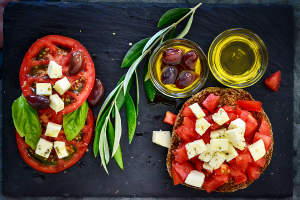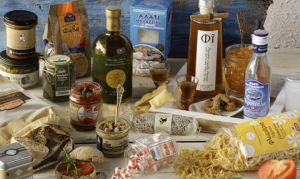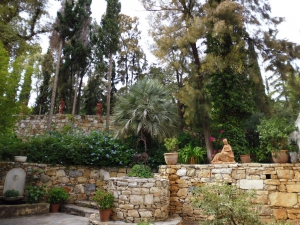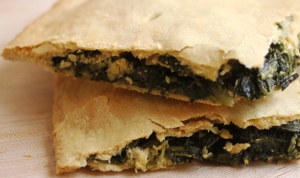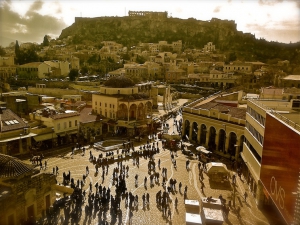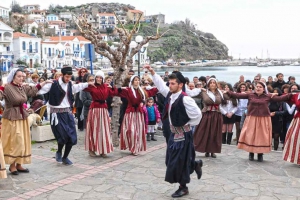LIFE & CULTURE
XpatAthens
Tuesday, 27 November 2018 07:00
How To Eat Like A Greek In 3 Steps
We know that the Mediterranean diet is considered one of the healthiest, if not the healthiest diet in the world.
The culinary habits of Greece and southern Italy offer numerous health benefits from heart protection to mental health.
This diet is based on simple ingredients such as olive oil, vegetables, fruit, beans, yogurt, cheese, some fish, a bit of meat and plenty of herbs. And while these ingredients may sound simple, they are nutritionally complex, full of antioxidants, substances that protect the body from various chronic diseases.
Anyone can make their diet more Mediterranean by using mostly olive oil for their cooking needs, eating plenty of seasonal fruit and vegetables and eating less meat. Here are simple steps to get you started:
Make Greek Style Open Sandwiches
In Greece partucularly in Crete a popular dish is the Dakos, a whole grain barley rusk (paximadi) topped with soft white cheese, tomatoes, olives and drizzled with olive oil. You can make your own by substituting a thick piece of toasted whole wheat bread. Top first with tomatoes, than crumbled feta cheese, a few olives, add some olive oil and a sprinkle of dry oregano.
Eat Vegetables as a Main Course
Greeks have the highest consumption vegetables in the world according to a latest study from the Tufts University. How do they do this? The answer is vegetable casseroles. Greeks consume so many vegetables because they serve them as a main course. Use fresh or frozen vegetables; almost anything will do, but the best are green beans, peas, okra and cauliflower. Sauté a chopped onion in 4 tablespoons of olive oil, add about 500 grams of vegetables and continue sautéing. Next, add about 250 grams of crushed tomatoes, a bit of parsley, salt and pepper, and some water, enough so that it halfway covers the vegetables. Let it simmer for about an hour. Serve with a slice of fresh bread and feta cheese.
To read more, please visit: The Food and Leisure International Guide
Published in
Greek Food & Diet
Tagged under
Thursday, 14 May 2015 07:00
Greek Tourism Expo Takes Two, Explores Leisure, MICE Travel
Leisure and MICE tourism will be the focus of the 2nd Greek Tourism Expo to take place at the Athens Metropolitan Expo on 4-6 December, when sector professionals come together to discuss challenges, offer solutions and forge ties for the most effective promotion of the Greek tourist product.
Organised by LeaderExpo, the three-day event offers a platform of exchange for professional bodies, municipal authorities, entrepreneurs, tour operators and tourist agents as well as cruise companies, managers and marketing experts.
For more information, please visit Greek Travel Pages
Published in
Greece In The News
Tagged under
Wednesday, 13 May 2015 07:00
You've Met A Greek Mother If You've Heard These Phrases
Have you ever met a Greek mother? It was Mother’s Day recently and maybe you visited Greece or plan to, or you may have Greek friends around the world, or maybe your roommate is a Greek. Next time you hear these phrases from their Greek mothers, it is good to know what they mean.
What a Greek Mother will say and what it means
- Keep your eyes fourteen! (Means: be cautious).
- The feet revolted and want to hit the head (Means: denouncing authority).
- I ate the whole world to find you (Means: I looked everywhere).
- That’s just a small chandelier (Means: It’s not that big a deal).
- If that is true you can pierce my nose (Means: No way that is true).
- She/He will fit your two legs in 1 shoe (Means: She/He will do with you as he/she pleases or/and push you around).
- The lid rolled and found the kettle (Means: These people are the same or/and think the same way, one fits on the other).
- I got fleas in my ears (Means: I am suspicious for something I am thinking or have heard. By the way, it’s origin is from an actual torture in Byzantine times).
- She/He will cook the fish on your lips (Means: She/He will torture you with nagging or other psychological way).
- She/He will change your lights (Means: Same as above. The actual origin of this phrase comes too from an actual torture).
- Though we haven’t seen him yet, we call him Yiannis (Means: We still don’t know what/who is, yet we have labeled him with something. The origin comes from an anecdote with Kolokotronis and Nikitaras at the Greek revolution of 1821).
Common phrases a Greek Mother will use to “work you around”
(Some are used by Greek fathers too)
- If you or your brother want to kill each other, get out. I just finished cleaning the floor.
- Pray the carpet stain can be removed.
- I am going to get your semester grades. If they are not good you better leave the house and not find you when I come back.
- What do you mean “why?”. Because, I said so!
- If you fall and bleed your knees, you will get spanked because you would have ripped your trouser too!
- Change your underpants! Suppose you have an accident and end up to the hospital. What would doctors say.
- Stop crying without a reason, or I will give you a reason to cry.
- Sure, that is a nice shower you had. Can’t you see that the back of your neck is still black/dirty?
- Close your mouth and eat your lunch.
- Your room is like being hit by a hurricane.
To read more, please visit: A Greek Adventure
Published in
Greek Language & Culture
Tagged under
Wednesday, 13 May 2015 07:00
Local Food Lovers Have Three Big Treats Coming Up
Greek food is taking center stage at a number of unlikely locations around Athens this month. Over 500 Greek producers, prominent chefs, restaurateurs, hotel owners, wine professionals and food specialists are participating in three large-scale gastronomy festivals taking place at the Technopolis cultural complex in Gazi, Stadio Irinis kai Filias (Peace and Friendship Stadium) in Neo Faliro and the Benaki Museum’s Pireos Street annex.
The past few years have seen local foodies moving away from international trends and focusing more on Greek flavors, products and small producers. Is this a form of roots revival, a patriotic effort to support local producers, a healthy rethink of traditional dishes, or even a kind of introversion during this difficult period? Possibly a combination of all of the above, but the fact that it leads to the development of local culinary culture is certainly a key positive point.
Following four highly successful events, “Greece, Celebration, Flavors” a festival organized by Athens city guide Athinorama and its food-focused sibling Athinorama Umami, has become quite an institution. Featuring 130 Greek producers, this year’s event starts today and runs through Sunday at Technopolis. The parade of Greek products will be complemented by a number of culinary and cultural events, concerts and visual art activities. During the course of the festival, the products on display will also be on sale, allowing visitors to sample the goods at their own leisure.
On the same days, the Peace and Friendship Stadium turns into a culinary arena and open-air market. The first edition of the Athens Food Festival will host over 200 small producers from around Greece presenting more than 500 types of traditional local products, recipes and culinary secrets from across the country, while noted Greek chefs and food specialists will also take part in presentations.
The festival’s program is based on four core themes: culinary presentations, product display, tastings and conferences. The event’s agenda includes an exhibition of high-quality products from small Greek producers, such as cheese, wine, honey and flour, as well as workshops and demonstrations of production methods used in rural parts of the country. A traditional olive press – billed as the largest ever to be erected at a trade show – will be used for the in situ production of virgin olive oil from a selection of Greek varieties, including the Koroneiki, Manaki and Ladoelia, among others.To read more, please visit ekathimerini
by Yiouli Eptakili
Published in
Local News
Tagged under
Tuesday, 12 May 2015 07:00
The Vorres Museum - A Garden Paradise
Located in six acres of lush gardens in Paiania, near Athens Airport, the Vorres Museum was founded in 1983 by Ian Vorres in order to promote Greek art and culture through a diverse range of activities, exhibitions and children’s activities. A graduate of Athens College, Mr Vorres was a famous Greek art collector who studied Economics and Political Science at Queen’s University in Ontario, Canada and furthered his studies with a Diploma in Philosophy and Psychology from the University of Toronto. After a career in Journalism in Canada, Between 1991-1998 Mr. Vorres served as Mayor of Paiania – the area of Athens where the Museum is located. He passed away in February 2015.
Divided into two sections: Contemporary and Folk Art, both museums showcase over 2,500 years of Greek history. I have had the fortunate experience of visiting Vorres twice now – once when I experienced St. Thomas’s B&B in nearby Paiania, the second time in October 2014 when TBEX hosted its European conference in Athens, they held their Speakers Party in the gardens.
Whilst the museums are interesting, I couldn’t stop marvelling at how peaceful the gardens were and could happily sit for hours. My second time I spent more time being shown the Folk and Contemporary Art. Both are fascinating and the art space is housed in a warehouse style building – but the aesthetics work well and are in keeping with the surroundings. Exhibitions are changed according to which artist is in residence.
Rental
It's possible to rent the space out and I’ve been told by friends that Vorres makes a fantastic location for a wedding. With the ability to host up to 700 people, with its gardens and location under Mount Imittos, I would certainly consider holding an event here! Check out their events page for more information.
Published in
City Discovery
Tagged under
Tuesday, 12 May 2015 07:00
Five Best Greek Foods You Should Be Eating Now
1. Vegetable Pies. Yes, you read right. Pies, a health food? Yes actually as long as they are made the Greek way. Pies - or pites as we call them here in Greece (not to be confused with pita bread) - usually contain a bunch of vegetables along with herbs, olive oil and sometimes cheese, wrapped in phyllo. The most popular one is the spinach pie (spanakopita), but you also find greens pie (hortopita), leek pie, pepper pie and the list goes on and on. You get the goodness of vegetables all wrapped up in the crunchy phyllo. They are great to take along on picnics or for a quick lunch or as a side dish.
2. Greens. In Greece they are called horta. Wild greens are the best if you have the opportunity to find them, but cultivated ones will do just fine. This is a unique part of the Greek diet; eating wild plants and leafy greens, lightly boiled with a bit of olive oil and lemon. They are rich in vitamin A, C and calcium, but mainly in antioxidants that play a role in protecting against cancer and other chronic diseases.
How? Buy some leafy greens and boil them. Serve with lemon juice and olive oil, accompany with bread and a piece of feta cheese.
3. Cretan Barley Rusks-Paximadi. These barley rusks are not only a popular food in Crete and the rest of Greece but they are extremely good for you. The authentic Cretan rusks are made from 100% barley flour baked till they are hard. It is a source of whole grains, which means that keep you satisfied, and keeps your appetite under control. Several studies have shown that consumption of whole grain products (at least 3 servings a day) can reduce the risk of diabetes by 30 percent. Furthermore, research conducted by the USDA (U.S Department of Agriculture) showed that a diet rich in barley may reduce cholesterol levels. Barley contains tocotrienol, natural form of vitamin E, which inhibits the production of cholesterol. Finally, preliminary investigations showed that they might reduce the risk of ulcers.
How? Find them online or specialty markets. Soak the rusk in water, drizzle some olive oil, load with tomato and cheese and enjoy.
To read more and to get more recipes with these ingredients, visit Food and Leisure International Guide
Published in
Greek Food & Diet
Tagged under
Friday, 08 May 2015 10:04
Possible Flat Rate VAT At 18%
The flat value-added tax rate being considered by the government will have to be set at 18 percent in order to have a neutral impact (neither positive nor negative) on its revenues. A lower rate of 16 percent, which is apparently being considered by the government, appears not to have been accepted by Greece’s creditors as it would create a fiscal gap and would entail additional austerity measures.
There are currently three VAT rates (6.5, 13 and 23 percent), as well as a 30 percent discount on each for the Aegean islands. The Finance Ministry has calculated that the average rate comes to 17.025 percent; however, it is also planning to exempt certain drugs and a number of food items, which means that the single rate will have to be pushed up to 18 percent to have a neutral impact on revenues.
If the measure passes and the flat rate of 18 percent is imposed from the second half of the year, households will face a significant added burden as the bulk of their expenses are food and electricity, both of which currently carry a 13 percent VAT rate.
Brussels counters that VAT evasion will be reduced with the introduction of a flat rate, noting that most of the tax dodging concerns services taxed at 23 percent. This was the case when the previous government reduced the rate on catering from 23 to 13 percent.
To read more, please visit: eKathimerini.
Published in
Local News
Tagged under
Thursday, 07 May 2015 15:33
Playing The Athens Tour Guide
Summer heat and sunshine brings everyone out of winter hiding, and this includes tourists and friends from far away places. This past week I had the pleasure of playing tour guide to a group of 5 colleagues from various parts of Europe. We had planned a short 2-day team-building break, a well-earned escape from the everyday pressures of work. For most of them, it was their first time in Athens, and expectations were high!
I had planned a jam-packed schedule, an introduction to some of the city's highlights and a taste of 'my Athens'... And I do mean 'jam-packed'. By the end of their stay, we all felt like a week had passed, rather than just 48 hours.
Here's what we did:
After arrival, coffee on the rooftop of the Athens Gate hotel (where they were staying). This is a mid-range hotel, perfect for a city break, in arguably the best location in the city, and with a 3600 rooftop view that is not to be missed.
We wandered around the Acropolis area, and climbed the hill up to the Areopagus for some photos. Then, already in need of more caffeine, we popped in to Root Artspace for a quick refuel.
Dinner was at Kotili taverna on Adrianou St. This is a better-than-average tourist taverna, which also attracts locals, and has live music 7nights per week. If the right crowd is there, you may find some of them dancing too!
The evening ended with a drink at TAF - a city-centre fave hidden away in Monastiraki.
The next morning we did a fun tour of the historical centre with Athens Segway Tours. 2 hours of spinning around the pedestrian streets to see all that we can see - they loved it.
Then we grabbed a taxi and headed towards Glyfada for lunch at Balux House Project. This is a full-on playground for young and old, literally right on the beach, with a delicious menu (from pizza to sushi), and a great relaxed vibe. This was a definite highlight for my guests!
Back to the centre for a quick shopping break... And off to Athens Clue - this is one of the super-popular 'escape rooms' that have taken the city by storm. You take a group of 5-6 friends, get locked in a room, and have 60minutes to figure out the clues and escape the room. Of course, we didn't manage to escape in time - surely we had a very difficult room...
Dinner was at Moma - my default dinner spot in the Monastiraki/Adrianou corridor. On the walk back towards their hotel, we stopped off at Yiasemi, on the famous stairway of Mnisikleous St., for a nightcap and a toast to a wonderful couple of days.
"Can we move our office here?" and "You live in paradise!" were the overall comments. Sure, on the company's tab, everywhere could be paradise. But my colleagues are well-travelled and worldly people. If they think Athens is brilliant, who am I to argue...?
Until next week,
Jack
Balux House Project
Athens Segway Tours
Athens Clue
Published in
My Week In Athens
Tagged under
Monday, 11 May 2015 11:30
British Airways Flies Direct From London To Six Greek Islands This Summer
British Airways announced its Greece summer 2015 schedule which will link London to six Greek islands, two of which are new destinations for the airline.
In addition to flights to Kos, Rhodes, Mykonos and Santorini, this summer British Airways will fly direct to Heraklio and Corfu. The last time British Airways flew to Heraklio was some 30 years ago.
“This demonstrates the distint support of the airline to Greek tourism and gives even more passengers the possibility to visit these destinations”, British Airways said in an announcement.
“British Airways continues to invest in the Greek market, expand its route network and proceed with actions that will boost tourism, local communities and their economies”, said Freddie Stier, the commercial manager of British Airways in Greece.
Published in
Greece In The News
Tagged under
Monday, 11 May 2015 08:00
Authorities Ask Culture Ministry To Include Ikaria Dance On UNESCO List
Authorities and academics from the North Eastern Aegean island of Ikaria, as well as Diaspora Ikariots, are calling on the Greek culture ministry to apply to UNESCO for the inclusion of Ikaria’s traditional dance, the “Ikariotiko”, on its Lists of Intangible Cultural Heritage.
In a letter sent last month to Deputy Culture Minister Nikos Xydakis, Ikariots are citing the example of Andalusia’s flamenco dance, which has already been placed on the list.
Known as “Kariotikos” by the locals, the three-part dance which gradually builds up pace, should, they say, be preserved and recognized as a property of the world and an integral part of Greek culture. Describing it as a cultural asset, the Ikariots are calling for the unique-to-Ikaria dance to be safeguarded.
UNESCO’s Lists of Intangible Cultural Heritage aim to ensure the protection of important oral and intangible cultural traditions worldwide, raising awareness of their significance.
To read more on this, please visit Greek Travel Pages
Published in
Local News
Tagged under

